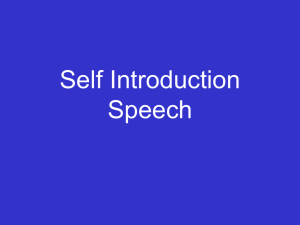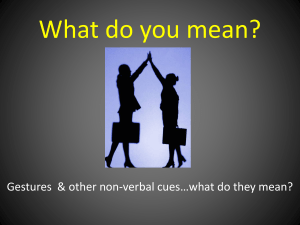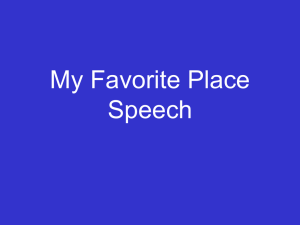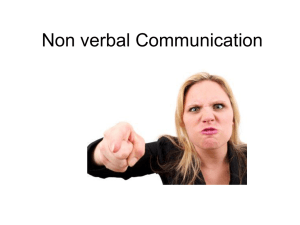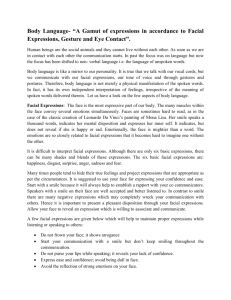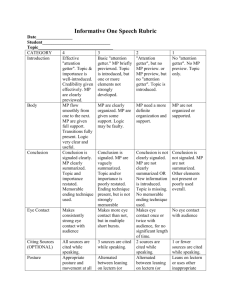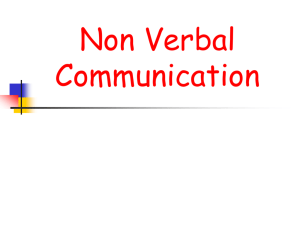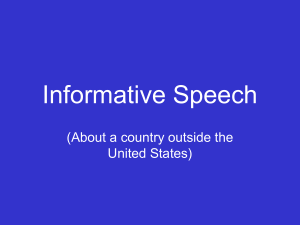Non-Verbal-Communication-Series-1
advertisement
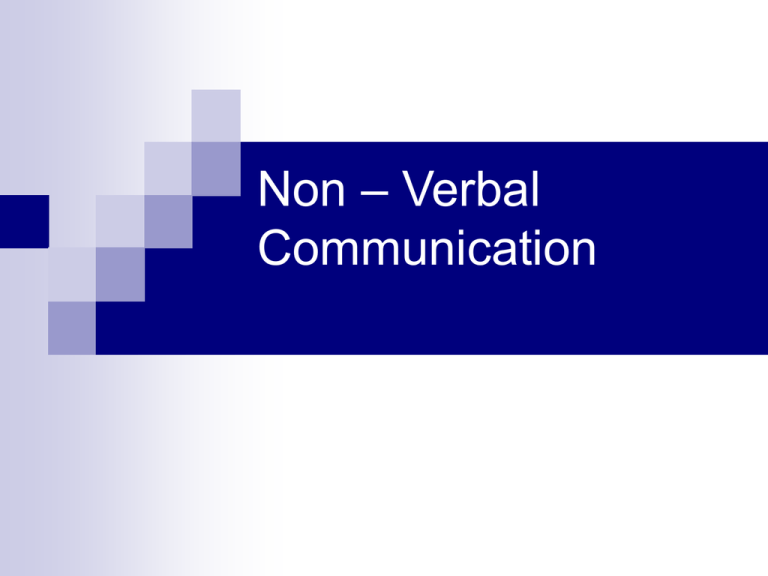
Non – Verbal Communication Definition Bartol and Martin Define non- verbal communication as ” communication by means of elements and behavior that are not coded into words”. Non-verbal communication includes body movements, the intonations or emphasis we give to words, facial expressions and the physical distance between the sender and the receiver. Relationship between Verbal and Nonverbal Communication Complement, modify, or elaborate Accent or emphasize Contradict Regulate interaction Repeat Substitute Kinesics Facial Expressions Gestures Bodily action Posture Facial Expression A facial expression results from one or more motions or positions of the muscles of the face. These movements convey the emotional state of the individual to observers. Facial expressions are a form of nonverbal communication. Facial expression along with intonations, can show arrogance, aggressive, fear, shyness and other character that could never be communicated if you read a transcript of what have been said. Examples Top class comedians tell there jokes with a dead pan expression that evokes more laughter than the word themselves In Asian countries like India the eyes have a special role to play in conveying messages. Averted eyes, down caste eyes, glaring eyes are the favourite stock in trade of Indian actors and actresses and more significant is the part played by the eyes in dance forms like the Bharatnatyam and the Kathakali. Sign: The act of communicating a mood, attitude, opinion, feeling, or other message by contracting the muscles of the face. Usage: The combined expressive force of our mobile chin, lip, cheek, eye, and brow muscles is without peer in the animal kingdom. Better than any body parts, our faces reveal emotions, opinions, and moods. While we learn to manipulate some expressions (see, e.g., SMILE), many unconscious facial expressions (see, e.g., LIP-POUT, TENSE-MOUTH, and TONGUE-SHOW) reflect our true feelings and hidden attitudes. Many facial expressions are universal, though most may be shaped by cultural usages and rules (see below, Culture). Gestures: While facial expressions are used to show emotions, gestures are used to show emotions and also convey definite messages or information. Most of the basic communication gesture are the same all over the world. When we are happy, we smile; when angry, we frown; when sad, we cry and tears roll down our cheeks. Common Gesture Clusters Readiness Common Gesture Clusters Nervousness Common Gesture Clusters Boredom or Impatience Common Gesture Clusters Enthusiasm The Ring or ‘OK’ Gesture: There ‘OK’ implies “all correct” and it has none filtered down to mean ‘everything’s fine. But in France it also stands for ‘zero’ or ‘nothing’ and in Japan it means ‘money’. The V-sign: The V-sign is popular in all Western countries and many other parts of the world. It is a hand sign indicating victory. Example: For example, people who are deaf and dumb have to rely almost entirely on gestures in order to communicate with other people. A gesture is a movement of the hand, head or body to indicate an idea or a feeling. Nonverbal sign. 1. A body movement, posture, or material artifact which encodes or influences a concept, motivation, or mood (thus, a gesture is neither matter nor energy, but information). 2. In its most generic sense, a gesture is a sign, signal, or cue used to communicate in tandem with, or apart from, words. 3. Gestures include facial expressions (e.g., EYEBROW-RAISE, SMILE), clothing cues (e.g., BUSINESS SUIT, NECKWEAR), body movements (e.g., PALM-DOWN, SHOULDER-SHRUG), and postures (e.g., ANGULAR DISTANCE). Many consumer products (e.g., BIG MAC®, VEHICULAR GRILLE, VEHICULAR STRIPE) contain messaging features designed to communicate as signs, and may be decoded as gestures as well. 4. Those wordless forms of communication omitted from a written transcript. (E.g., while the printed transcripts of the Nixon Tapes reported the words spoken by the former president and his White House staff, they captured few of the gestures exchanged in the Oval Office during the Nixon years.) Body Language In body language body movements convey meanings and message. The shape of your body conveys a message and tells other people about your life stlye. In a strict sense gestures are a part of body language for our heads and hands are part of our bodies. Message clusters Body language comes in clusters of signals and postures, depending on the internal emotions and mental states. Aggressive body language: Showing physical threat. Bored body language: Just not being interested. Deceptive body language: Seeking to cover up lying or other deception. Defensive body language: Protecting self from attack. Emotional body language: Identifying feelings. Closed body language: Many reasons are closed. Evaluating body language: Judging and deciding about something. Open body language: Many reasons for being open. Power body language: Demonstrating one's power. Ready body language: Wanting to act and waiting for the trigger. Relaxed body language: Comfortable and unstressed. Romantic body language: Showing attraction to others. Submissive body language: Showing you are prepared to give in. Posture Posture is an important element in body language as it often gives a key to the personality of the being and tells us a great deal about him or her. From the posture or the person holding himself we can know whether he is confident, diffident, old, young, weak, strong or unhealthy. Example A slouching posture means laziness; rounded shoulders and an out thrust neck indicate a scholar, a swaggering or handin-the-pocket posture could indicate overconfidence or an ill bred person. Nonverbal sign 1. A bearing, pose, or stance of the body or it parts: e.g., a crouched posture. 2. A fixed, stationary body position as opposed to a fluid body movement. Usage: When sustained (i.e., held longer than two seconds), a body movement such as a bowed-head may be considered a posture. Though duration varies, postures frequently are more expressive of attitudes, feelings, and moods than are briefer gestures and fleeting motions of the body. Silence: Paradoxical as it may sound, we communicate with the help of silence. Sometimes we are so overcome by emotion that we cannot speak – our silence tells the other person of our strong feeling. Indeed there are many occasions when ‘silence is more eloquent than words’ Example A joke at a party is greeted with silence – people disapprove of the joke or the speaker. The student keeps silent for a few moments before answering a question – he is thinking. Signs and Signals: The English words ‘sign’ and ‘signal’ are both derived from the latin word ‘signum’ which means a mark. Signs and signals become very important means of communication when the communicants do not have a common language. The language of signs and signals, therefore, has a universal nature, being understood all over the world. Examples For examples, deaf and dumb persons are taught to communicating words with the help of a sign language. In the same way the Red Indians of America had an elaborate sign language. Graphs, Maps and Charts: Graphs, charts and maps are other types of visual, but non-verbal communication It must however be mentioned that the communicator who uses graphs and charts requires to have special skills and techniques to prepare them and the person who reads them must have an educated background. A chart is not really different from a map or graph in the sense that usually graphs or maps are mounted on charts for better visual effect. Colour Colour plays such an important role in our lives that, as far as English is concerned, colour symbolism has become apart of the language. Thus we speak of people turning “green with envy” (jealous), “turning yellow” (coward), “pink of health”, “blue” (depressed). Colours are also used to convey direct messages. Traffis lights turn red and green and in operation theater a red bulb is used to show that the theatre is in use Light colours have a soothing effect on people while bright stark colours excite and dark ones have depressing effect. Colour Positive Message Negative Message Red Wramth Passion Life Liberty Patriotism Death War Revolution Devil Danger Blue Religious feeling Devotion Truth Justice Doubt Discouragement Yellow Intuition Wisdom Divinity Cowardice Malevolence Impure love Green Nature Hope Freshness Prosperity Envy Jealous Opposition Disgrace Thank you.

